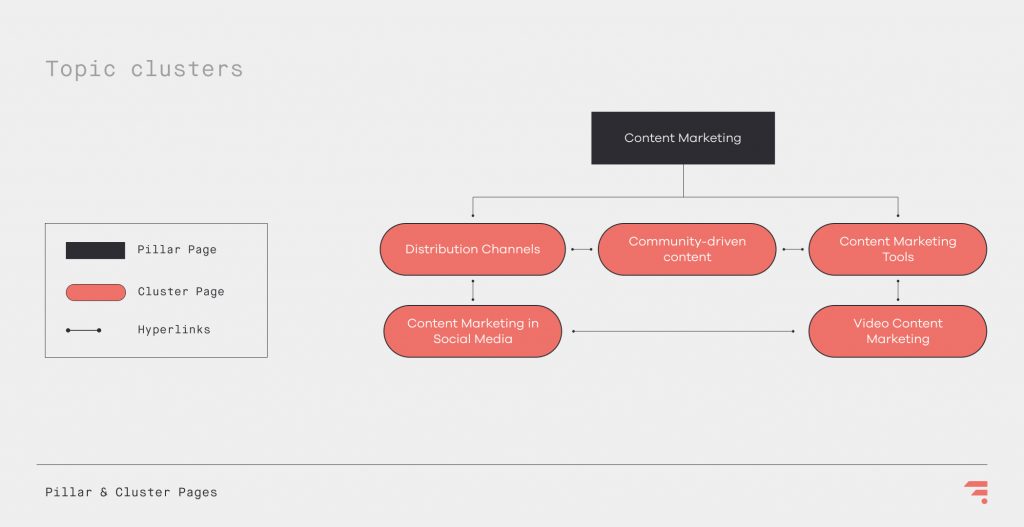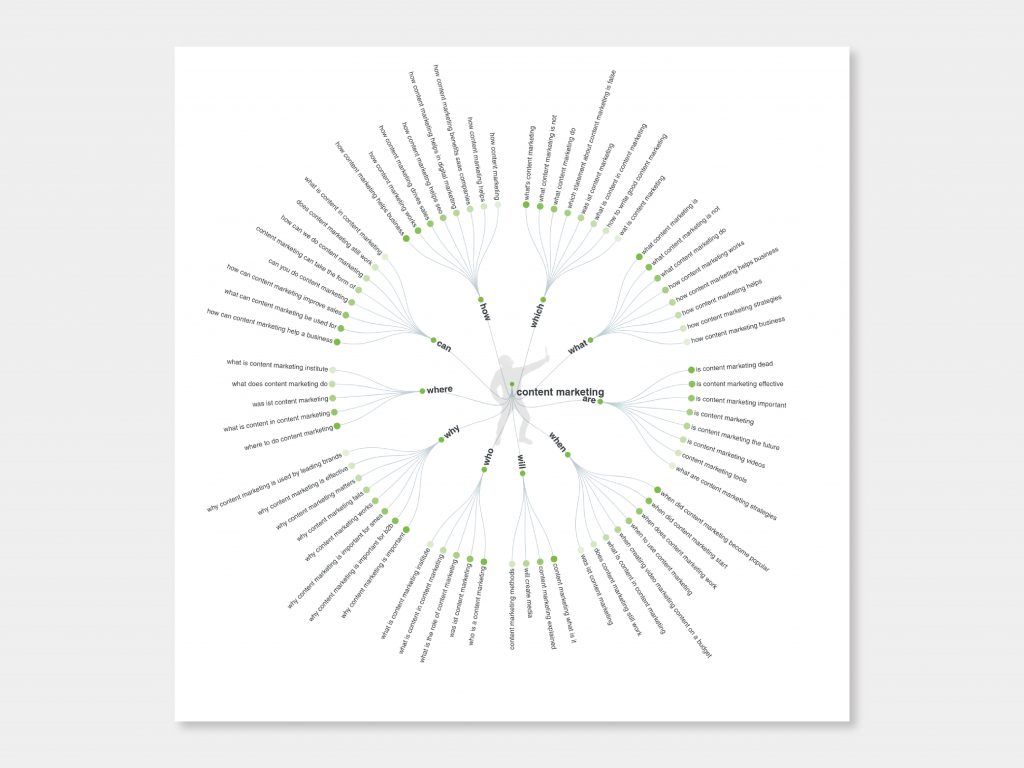What is a pillar page and how can it help SEO?
12th May 2022

If you’ve landed here, you’re most likely trying to figure out how to improve your content marketing. Maybe the website traffic coming through isn’t enough or you’re struggling to rank for high-volume keywords. That’s where topic clusters and pillar pages, otherwise known as content pillars, come in.
Implementing this strategy allows you to not only increase your website traffic and conversions but also improve your content quality & user experience. All whilst helping SEO. So, what exactly are pillar pages & topic clusters, how do they work, and what do you need to create one? Follow along to find out!
What is a pillar page?
Pillar page/content pillar is a long-form (+2000 words) piece of written content that provides a broad overview of a topic. That also includes links to thoroughly covered sub-topics (otherwise known as cluster pages).
In a nutshell, content pillars are the foundation of your content marketing strategy. Usually, acting as landing pages for the topic clusters your business tries to cover. And cluster pages are where you can find all the sub-topics explained. By interlinking them together, you make it easier for users & search engines to understand the content. In turn, ranking higher, capturing more organic traffic, and improving user experience.
Let’s say you’re trying to cover an ‘SEO’ topic cluster. Your content pillar would most likely be titled ‘Guide to SEO’ – covering the entire topic on the top level. This would be accompanied by various links within the text to the cluster pages. In which, you would find topics like: ‘what is search intent’, ‘best SEO practises’, ‘building backlinks for SEO’, etc.
In other words, pillar pages cover a topic broadly and cluster pages provide additional context.
What are topic clusters?
Topic cluster is a method of organising and interlinking related content around one core topic. Each cluster has a pillar page (broadly covering the core topic) and accompanying cluster pages (covering the sub-topics in-depth).

By producing content based on chosen topic’s keywords and interlinking them to a content pillar on the same topic – you’re creating a topic cluster. By organising your content this way, you’re answering your audience’s questions as they get them. As well as, making it easier for search engines to understand your content – increasing your organic results.
Imagine this scenario, you’re reading a blog (content pillar) titled ‘How to create a content marketing strategy?’. As you’re moving along you land on a mention of ‘content distribution’, that you’ve no idea about. The blog explains what it is but doesn’t go in-depth on how to distribute content. But they have a link which goes straight to another blog (cluster page) explaining all the ways you can distribute content. Which provides you with a satisfying user experience by having easy-to-access answers, for questions that can come up while reading.
How do pillar pages help SEO?
Pillar pages are an excellent way of organising your content. They tend to help user experience and search engine crawlers alike. So, what are the main SEO benefits of implementing this strategy?
Improving the site structure
First and foremost – pillar pages help to organise your content. It makes it easier for users to navigate your website and consume content. Additionally, it allows Google to understand the meaning behind your content better.
Organising your content in a form of topic clusters (pillar pages & cluster pages), which are targeting related keywords, says to search engines that this is the exact topic we’re talking about. And captures a wider variety of long-tail keywords. It leaves little to no room for guesses – making your organic ranking more competitive.
In other words, thought-through linking helps users & search engines to understand the topics you’re covering better. More internal links mean higher SERPs placements.
Targeting high-volume keywords
If you’ve ever tried ranking for high-volume keywords, you probably know how difficult & competitive it can get. Where there is a high volume of searches – there is a massive potential to capture all that organic traffic.
And if there are a lot of searches, there will also be a lot of websites trying to rank for those keywords. So, the way to succeed at ranking for those keywords is by producing high-quality content, which is highly favourable to Google.
How do pillar pages tie into this? Well, they act as a guideline to produce quality content. Not only do you become a trustworthy source on the topic, but also start earning backlinks which increases your rankings even more. Of course, there are other ways to land high-quality backlinks, that we explain in another blog.
High-volume keywords bring a lot of competition -> with a lot of competition content quality increases -> by producing quality content your website ranks higher -> which also brings more backlinks -> continuing to increase your SEO results -> to be able to rank better for other keywords… And that’s the endless cycle of SEO.
Presenting your industry expertise
By creating quality content you’re effectively building a knowledge bank on your website. Especially if you’re focusing on educational evergreen content – which requires little to no maintenances and can stay true for years.
One of the best examples of this, in the marketing industry (mainly SEO & content marketing), are SEMrush & HubSpot blogs. You’ll find one of them on the first page of SERPs for most SEO & content marketing related queries. The amount of evergreen content they’ve built throughout the years continues to bring organic results up until this day.
So, if you want your business’s website to be the go-to place for educational content in your niche – pillar pages are a great place to start. Not only will their structure help you figure out how to produce good content, that covers topics from all angles, but also continue to build backlinks & increase your organic traffic. Presenting you as the expert.
How to create a pillar page?
We’ve already covered what are pillar pages & topic clusters, as well as why are they beneficial for SEO. The next step is to learn how to create them.
1. Choose your topics
First and foremost, decide which topics you want to rank for. Think of topics that are broad enough to cover in one pillar page, but not too broad that it would require multiple blog posts. So, something like ‘marketing’ would be way too broad. Alternatively, ‘content marketing’ would be a narrower and a more suitable topic.
Additionally, figure out keywords for the chosen topic and make sure they have adequate search volume. If there is close to no search volume – it’s hardly worth targeting those topics. Keep in mind, that you will start writing cluster blogs before creating the pillar page.
2. Conduct keyword research
Once you’ve picked out the topic clusters – it’s time to do some good old keyword research. This step is where you do a deep dive into search analytics. Discover as many related keywords as you possibly can. Try finding keywords to base your subtopics on.
Tools like Google Keyword Planner, AnswerThePublic, and SEMrush Magic Tool will prove to be extremely useful.

3. Organise the topic clusters
Now you’ve determined the topics & figured out relevant keywords. It’s time for probably the most important part of creating pillar pages – grouping keywords into topic clusters. If done wrong your clusters won’t successfully rank on SERPs. You should figure out what results your chosen keywords bring & how can you put them together to expand on your chosen topic.
So, if we’re continuing with the ‘content marketing’ example. The blogs that come up on SERPs, for that query, also talk about: ‘what is it’, ‘why it’s important’, ‘how it works’, and ‘how to create a content strategy’.
This step mainly makes sure, that the traffic you capture is as efficiently optimised as possible. As well as, avoiding repetition in cluster blogs.
4. Write cluster & pillar pages
Always try starting with cluster pages. You should have most if not all of them done before moving on to the pillar pages. Keep in mind, that pillar pages shouldn’t cover the subtopics too in-depth – you want to leave space for elaboration on your cluster pages.
It’s a fine balance between covering the topic too much or not giving enough information. Make sure to explain the related topics enough for users & Google to see the value but leave enough space so users would be inclined to move on to the cluster page.
5. On-site SEO & good linking practises
Don’t forget to employ good on-page SEO practices. Optimise headings, meta tags, alt-texts, links, and make sure your main keywords can be found within the content, etc. It’s worth looking into the four pillars of SEO, which will leave you equipped to start tackling SEO challenges.
Additionally, make sure you’re linking your cluster pages in relevant places (under accurate subheadings) within your pillar page. Use descriptive text to link, don’t say ‘click here’. You’re much better adding the hyperlink on the text mentioning the topic.
Final thoughts
Developing pillar pages & topic clusters is hard work but remember the results will be worth it. Not only will you position your blog as a knowledge bank, but also increase your search traffic exponentially.
Start by figuring out your topics. Do some keyword research. Group everything into topic clusters. Then write & optimise.
All your efforts will improve user experience, help Google understand your topics clearly, and raise your website’s authority. You may even start gaining backlinks organically.



